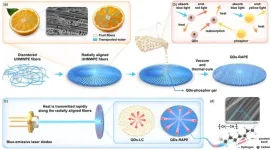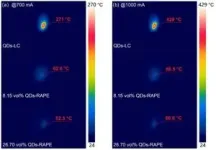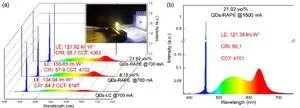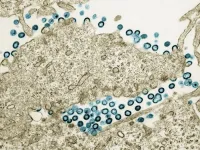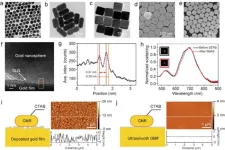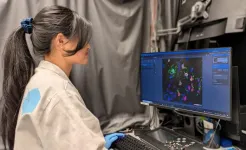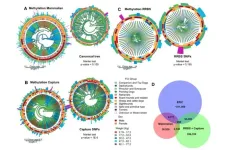A new publication from Opto-Electronic Advances; DOI 10.29026/oea.2024.240036 , discusses sharp temperature reduction for quantum dots in polymer by highly efficient heat dissipation pathways.
Quantum dots (QDs), a kind of luminescent nanocrystals featuring size-tunable emission spectra and superior color purity are widely applied in optoelectronic fields. However, these particles are facing luminous efficiency degradation due to their temperature-sensitive characteristic and the high temperature in optoelectronic devices. Thus, thermal management of nanoscale QDs is significantly important and challenging due to the poor heat-dissipated ability of polymer matrix where QDs are packaged.
To tackle above thermal issue in QDs-polymer composites, several strategies have been developed. Among them, incorporating QDs-polymer composites with highly thermal-conductive fillers with neglectable absorption of visible light stood out for simultaneously reducing QDs’ working temperature and maintaining the optical performances. The fillers are always microscale and they are discretely distributed in QDs-polymer, and heat is conducted rapidly in the discrete fillers phase while slowly in the continuous polymer phase. Its discontinuity makes the enhancement of heat conduction not efficient enough and this strategy fails in some high-power application, such as laser lighting. Thus, it is needed to improve the continuity of the fillers to effectively enhance the heat-conducted ability of QDs-polymer for the high-power applications.
The authors of this article propose a new strategy. Inspired by orange’s massive radially aligned fruit fibers which offers efficient pathways for transmission of water, they proposed a QDs-radially aligned ultrahigh molecular weight polyethylene fibers (UHMWPE fibers, UPEF) composites (QDs-RAPE) by constructing radially-aligned thermal-conductive networks in QDs luminescent composite (QDs-LC). The meter-scale length of UPEF (thermal conductivity ~60 W m−1 K−1) endows them with continuous and long-range heat dissipation pathways. The QDs-RAPE achieved an in-plane thermal conductivity as high as 10.45 W m−1 K−1 under UPEF volume ratio of 24.46%, which is the highest value of QDs polymer composites (mostly lower than 1 W m−1 K−1) reported so far. By utilizing the continuous heat dissipation pathways, heat could be efficiently conducted from the center to the outside thus releasing the high temperature.
When excited by a blue laser diode (LD) under driving current of 1000 mA, the QDs-RAPE with different UPEF volume fraction realized a huge temperature reduction over 342.5 ℃ compared with the traditional QDs-LC. The sharp reduction on the working temperature of luminescent composites would be beneficial for the optical performances of QDs-converted white LDs. Under driving current of 700 mA, 8.15 vol% QDs-RAPE exhibited high luminous efficiency (LE) of 155.85 lm W−1, as well as high color rendering index (CRI) of 87.9, while that of QDs-LC are 134.04 lm W−1 and 84.2, respectively. Besides, the CRI of 21.92 vol% QDs-RAPE could achieve 90.1 which produces a white light with a high lighting quality. The low working temperature of QDs-RAPE improved the optical performances and reliability of the optoelectronic devices.
QDs-RAPE under driving current of 700 mA. Inset is the photograph of QDs-RAPE with illumination. (b) Spectral power distribution and optical properties of 21.92 vol% QDs-RAPE under driving current of 1500 mA.
Keywords: quantum dots / UHMWPE fibers / radial alignment / heat dissipation / light-emitting devices
# # # # # #
Thermal Packaging Laboratory (TPL), group of Prof. Xiaobing Luo is from the School of Energy and Power Engineering, Huazhong University of Science and Technology. The group concentrates on the thermal and fluid issues in optoelectronic packaging, thermal management in extreme conditions and micropump for active cooling system.
Prof. Xiaobing Luo, is the recipient of the National Outstanding Youth Fund, IEEE Fellow and ASME Fellow, Dean of School of Energy and Power Engineering, Chinese Dean of China-Europe School for Clean and Renewable Energy, Huazhong University of Science and Technology. He has published 180 peer-review journal papers as the first author or the corresponding author, and authorized 59 Chinese invention patents and 5 US patents as the first inventor, of which 20 have been transferred to industry. He successfully developed the first micro hydraulic suspension pump and ultra-thin micro pump, as well as the thermal management framework for high-temperature logging tools. TPL Homepage: http://tpl.energy.hust.edu.cn
# # # # # #
Opto-Electronic Advances (OEA) is a rapidly growing high-impact, open access, peer reviewed monthly SCI journal with an impact factor of 15.3 (Journal Citation Reports for IF2023). OEA has been indexed in SCI, EI, DOAJ, Scopus, CA and ICI databases, and expanded its Editorial Board to 31 members from 17 countries with an average h-index of 62.
The journal is published by The Institute of Optics and Electronics, Chinese Academy of Sciences, aiming at providing a platform for researchers, academicians, professionals, practitioners, and students to impart and share knowledge in the form of high quality empirical and theoretical research papers covering the topics of optics, photonics and optoelectronics.
# # # # # #
More information: http://www.oejournal.org/oea
Editorial Board: http://www.oejournal.org/oea/editorialboard/list
All issues available in the online archive (http://www.oejournal.org/oea/archive).
Submissions to OEA may be made using ScholarOne (https://mc03.manuscriptcentral.com/oea).
ISSN: 2096-4579
CN: 51-1781/TN
Contact Us: oea@ioe.ac.cn
Twitter: @OptoElectronAdv (https://twitter.com/OptoElectronAdv?lang=en)
WeChat: OE_Journal
# # # # # #
Yang X, Zhang XF, Zhang TX et al. Paving continuous heat dissipation pathways for quantum dots in polymer with orange-inspired radially aligned UHMWPE fibers. Opto-Electron Adv 7, 240036 (2024). doi: 10.29026/oea.2024.240036
END
